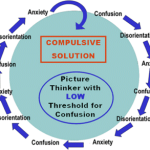Dyslexia and the Threshold for Confusion
 When dyslexic people make mistakes in reading or spelling, it is because they are experiencing disorientation, which results in distorted perceptions. The person’s threshold for confusion is a key factor in how often he or she disorients. A person with a lower threshold is more easily confused, and thus is more often disoriented. A person with a higher threshold is less easily confused and less frequently disoriented.
When dyslexic people make mistakes in reading or spelling, it is because they are experiencing disorientation, which results in distorted perceptions. The person’s threshold for confusion is a key factor in how often he or she disorients. A person with a lower threshold is more easily confused, and thus is more often disoriented. A person with a higher threshold is less easily confused and less frequently disoriented.
This explains why at certain times people can read and spell fairly well, and at other times they can’t. Their threshold for confusion changes.
After a person learns to detect and correct his or her own disorientations through Davis Orientation Counseling, and begins mastering symbols that cause confusion, the threshold for confusion naturally increases.
Besides confusion about words and symbols, there are other things in life that can lower the threshold for confusion and affect a person’s ability to maintain orientation. One should be aware of these other sources of confusion and resolve them whenever possible. They include:
- not enough rest;
- poor diet or not enough food;
- illness, pain, or injury;
- drugs or medicines;
- print size too small;
- print too faint;
- varying print styles and typefaces;
- loud noises;
- specific sounds;
- certain smells;
- poor lighting (can be too much or too little);
- excess motion (whirling fans, dangling decorations);
- a change in the orderliness of the environment;
- furniture rearrangement;
- moving households;
- scheduling changes;
- time pressure (being rushed);
- threats of punishment;
- family strife;
- fear;
- a loss;
- anything that is a reminder of an unpleasant past experience;
Davis Orientation Counseling will help a person to recognize and control disorientations, but it cannot prevent disorientations that stem from outside factors, such as those listed above. It is thus important for the person to also learn to recognize these sources of confusion, so they can be avoided, resolved or minimized.
Related Article
The Cause of Dyslexia: Anatomy of a Learning Disability


